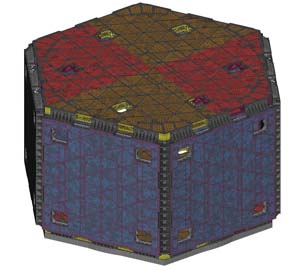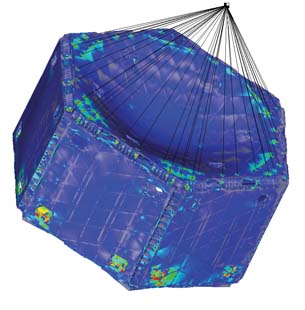Femap Plays Key Role in Modular Satellite
SpaceWorks Engineering, Inc. uses Femap with NX Nastran to develop a revolutionary modular design to build satellites in days, instead of years.
Latest News
May 1, 2010
By Russell Shuba
 Each panel of the satellite is composed of an outer skin of plate elements meshed over a framework of 8-node brick elements. This efficient FE construction technique limited the model size to approximately 800,000 nodes. Meshing the geometry with 10-node tetrahedrals would have resulted in an FE model in the range of tens of millions of nodes. |
SpaceWorks Engineering provides unique and advanced satellite solutions for a range of customers. One of the company’s current projects involves the development of the next-generation satellite structure for the U.S. Air Force Research Laboratory (AFRL). The system, appropriately named “Plug-and-Play Satellite“ (PnPSat), features a modular framework of panels that use a shared electrical and communication bus that can be quickly assembled into a fully functional and ready-to-launch satellite in a matter of days.
Depending upon the mission of the satellite, any number of “off-the-shelf” spacecraft component modules can be plugged into the panels, making the satellite ready for immediate launch.
A Revolutionary Leap
The approach represents a revolutionary leap forward. Typically, months and usually years are required to create a dedicated satellite. Conversely, the PnPSat system provides a turnaround time of just days for the right missions.
A key factor in the utility of the PnP satellite is its lightweight and rigid structural framework that facilitates the easy placement of spacecraft component modules (e.g., batteries and telescopic imagers). To allow commonality of usage, the framework was designed to launch the lightest combination of modules in any desired grouping. Determining the appropriate combination was not an easy process and required the extensive use of engineering optimization using finite element analysis (FEA).
To tackle the FEA end of things, SpaceWorks hired Predictive Engineering as its FEA specialist. “We chose Predictive Engineering due to the company’s unique blend of high-end analysis resources and ability to easily work within our engineering team in meeting our schedules and budget,“ says Jeff Preble, president of SpaceWorks. Using Femap with NX Nastran technology from Siemens PLM Software, Predictive Engineering built a series of elegant but complex FE models that allowed SpaceWorks to quickly gain insights into the structural performance of this novel spacecraft structure. Within weeks, SpaceWorks verified its new design and won accolades from AFRL.
Leveraging Advanced Analysis
The PnP satellite structure is composed of eight panels that are bolted together. Each panel consists of two symmetric halves. The panel has thick ribs to provide structural reinforcement with a thin outer skin. Meshing the geometry with 10-node tetrahedrals would have resulted in an FE model in the range of tens of millions of nodes and would have proven essentially unsolvable. A different design approach was necessary.
Predictive Engineering determined that the only practical approach was to mesh the thin skin using plate elements and the thicker ribs with 8-node bricks. Using the advanced meshing techniques in Femap, a completely mapped mesh (bricks and plates) of the PnPSat structure with a node count of approximately 800,000 was produced. Although large by most analysis standards, the FEA results for the structure’s normal modes were found to be within 5 percent of experimental results.
 Dynamic analysis of the PnPSat-2 satellite showed remarkable agreement with experimental results with normal mode predictions in the 5 percent range. Although the model was quite large (>800,000 nodes), run times were in minutes using Femap from Siemens PLM Software. |
“We knew we were pushing the technology of both Femap and NX Nastran with this model and such tight correlation just confirmed to us that we were on the right track,” says George Laird, principal mechanical engineer for Predictive Engineering. “To see such a good correlation on a very complex system model was impressive.”
In addition, solution times were in the range of minutes using a standard 64-bit PC computational platform. Without the advanced meshing tools within Femap—creating matched grids of 8-node bricks and 4-node quads—it would have been impossible to achieve the simulation accuracy required by SpaceWorks. “We knew that we had the right engineering analysis team on board when we saw that not only the model was accurate but we could generate optimization runs in minutes,” says Preble.
Strong Competitive Position
SpaceWorks’ development of the PnPSat structural system demonstrates its ability to rapidly respond with innovative solutions to highly complex engineering requirements. Preble points out, “Creating advanced models that are both accurate and fast definitely gives us a competitive edge and has become a critically important contribution on these fast-paced, technically challenging spacecraft projects.”
More Info:
Predictive Engineering
Russell Shuba is a freelance writer who lives outside Madison, WI. When he’s not tracking down the details of his latest assignment, he can be found plying the north country’s lakes in a homemade kayak or skiing in the backcountry. To comment on this article, send us an e-mail addressed to [email protected].
Subscribe to our FREE magazine, FREE email newsletters or both!
Latest News
About the Author
DE’s editors contribute news and new product announcements to Digital Engineering.
Press releases may be sent to them via [email protected].






